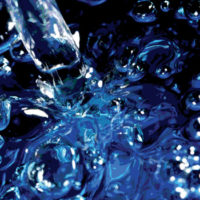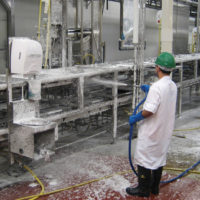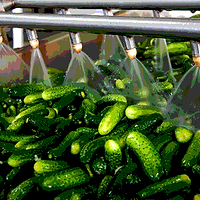Planet versus Profit

Production hygiene and cleaning are unavoidably linked. However, the environmental impact of traditional cleaning is in contradiction to a globally sustainable strategy. Sustainability is also about social responsibility and the global community. Creating a cleaner, healthier future for all begins at the doorstep of every producer. In order to make a public commitment to challenging and measurable reductions in environmental impact, innovative projects are required that will also drive continuous improvement in operational profiles and profits, and benefit people and the environment.
Background
A great deal has been written about sustainability, much of it confusing and even contradictory. Some even suggest that sustainability is the latest business fad and will soon be replaced by the next vogue. It is true that sustainability has developed from its original “green” concept and continues to go through further iterations and definitions. Moreover, as more organizations adopt sustainability practices and offer more sustainable products and services, any competitive advantage and differentiation will diminish, requiring businesses to differentiate themselves in other ways.
Exactly the same is true for green cleaning. At its outset, green cleaning essentially involved the use of environmentally preferable chemicals. Although an acceptable “first rung on the ladder” approach, green cleaning has gone through several developments, including the incorporation of environmentally preferable tools, equipment and paper goods.
At one level, green cleaning is a fad inasmuch as it is not endemic across all or even most organizations or countries. However, as regional legislation, such as REACH in Europe (the European Community Regulation on chemicals and their safe use: Registration, Evaluation, Authorization and Restriction of Chemical substances) or a globally harmonized system (GHS), becomes more prevalent, as organizations see the economic, social and environmental benefits of green cleaning and as competition pressures impact cleaning service providers, green cleaning will become more widespread and, ultimately, the norm.
Defining Green Cleaning
Green cleaning is an integral element of sustainability and, therefore, before defining green cleaning, we first need to define sustainability.
There are many definitions and interpretations of what sustainability entails. Many use “sustainability,” “green” or “environmental” interchangeably, but the most widely cited and accepted definition comes from the so-called Brundtland Report.
“Sustainable development is development that meets the needs of the present without compromising the ability of future generations to meet their own needs.”
The Brundtland Commission, formally the World Commission on Environment and Development, and known by the name of its chair, Gro Harlem Brundtland, has published in the Report of the World Commission on Environment and Development.[1]
The Brundtland definition has been further refined to become the “triple bottom line,” sometimes referred to as “3BL” or “TBL,” and is currently the most common concept used by large national and international organizations. The triple bottom line of social, environmental and economic factors, also known as “people, planet, profit,” uses an expanded scale of values and criteria for measuring an organization’s success. Figure 1 illustrates how sustainability is at the crossroads of these three ideas.

Therefore, it is reasonable to expect that a comprehensive green cleaning program should encompass not only environmental considerations, but also social and economic considerations.
Defining Green Chemicals
There are many valid, and arguably as many invalid, interpretations or definitions of a green cleaning element. Many definitions/interpretations go beyond what the product should and should not contain. However, there is a common notion that a “green” or “environmentally friendly” chemical is denoted by a valid eco-accreditation such as the EU Eco-Label (“EU Flower”) and the Nordic Eco-Label (“Nordic Swan”) in Europe, and Green Seal and Environmental Choice in North America.
That is not to say that one accreditation is better or worse than any other, merely that there are differences and, as such, eco-labels are not an ultimate definition of “green.” Moreover, few, if any, eco-labels have specific criteria for products that have a disinfection or sanitization function.
Apart from eco-labels, other definitions of “green” require that the product be biodegradable and/or “natural.” However, these conditions also raise issues.
Biodegradable:
Many cleaning products claim to be “100% biodegradable.” In Europe, there are two important points to note on biodegradability:
1. Biodegradability is only defined for organic substances, that is, those substances that contain carbon. Inorganic substances that do not contain carbon, for example, sodium hydroxide, are not by definition biodegradable.
2. Technically, biodegradability is defined for substances (essentially single raw materials) and not for mixtures.
Given that the vast majority of cleaning products are a mixture of a number of organic and inorganic substances, including water, it would be inaccurate to claim that a cleaning product is “100% biodegradable.” Regarding surfactants, it has been the law in the European Community since 1978 for surfactants to be biodegradable. Thus, unless there was something unique or specific about the biodegradability of the surfactants used, which should be identified by the manufacturer, a user cannot claim and should not infer that one product is superior to another solely by a biodegradability claim.
Natural:
An ever-growing number of products claim to be “natural.” However, there is the very common misconception that being “natural” is somehow better for human and/or environmental health. In nature, there are many things that are harmful—asbestos, cyanide, mercury, HIV—to name but a few. Of course, the cleaning industry needs to reduce its reliance on petroleum, as it is a finite resource, but “natural” cleaning products are not necessarily the answer.
The discussion document “Meeting Natural Expectations,” published by the UK Cleaning Products Industry Association, points out that the separation of things “natural” from things “chemical” is irrelevant and essentially meaningless. Indeed, arguably, the greatest uses of natural materials in the majority of cleaning products are fragrances. Due to human health concerns over some fragrance ingredients, eco-labels tend to control/limit their use, and some are even banned under the Environmental Choice Program Standard for Household, Industrial and Institutional Hardsurface Cleaners, CCD-146 March 2007.[2] However, whether it is an eco-label, biodegradable, natural or any other environmental claim, there is considerable risk of greenwashing.
In December 2007, the environmental marketing firm TerraChoice released a study called “The Six Sins of Greenwashing,”[3] which found more than 99 percent of 1,018 common consumer products in North America randomly selected for the survey were guilty of greenwashing. According to the study, the six sins of greenwashing are:
• Sin of the Hidden Trade-Off: For example, “energy-efficient” electronics that contain hazardous materials
• Sin of No Proof: For example, shampoos claiming to be “certified organic” but with no verifiable certification
• Sin of Vagueness: For example, products claiming to be 100 percent natural, when many naturally occurring substances are hazardous, like arsenic and formaldehyde
• Sin of Irrelevance: For example, products claiming to be CFC-free, even though CFCs were banned 20 years ago
• Sin of Fibbing: For example, products falsely claiming to be certified by an internationally recognized environmental standard like “EU Flower”
• Sin of Lesser of Two Evils: For example, organic cigarettes or “environmentally friendly” pesticides
In April 2009, TerraChoice published a second report on the subject. This report noted the emergence of a seventh Sin—the “Sin of Worshiping False Labels” committed when a product, through either words or images, gives the impression of third-party endorsement where no such endorsement actually exists—fake labels, in other words.
The ecological mantra is Reduce, Reuse, Recycle, in that order. It is much better to reduce the amount of, say, plastic waste than to be primarily concerned about recycling that waste. At this point, it is worth clarifying what “recycling” means. “Recycling” is about taking a waste product, such as packaging, and through a relatively complex process, turning it into something else that is useful. Therefore, taking waste plastic packaging and turning it into a garden bench or a signpost is recycling. Refilling empty containers following minimal processing, such as rinsing, is reusing.
With that in mind, cleaning products should be:
1. As concentrated as possible/practicable, as this reduces the amount of manufacturing energy and transportation waste in moving to and from the manufacturer/customer and waste packaging.
2. In the largest container as possible/practicable, as, obviously, very large containers create issues such as manual handling, storage, budgetary constraints, shelf life, etc., but they reduce production of and waste resulting from packaging.
3. Products with integral dilution control measures, as this reduces not only the amount of waste chemical due to overdosing but also the resultant waste packaging, transportation, etc. and the impact of using too many chemicals.
It may always be possible to find a “greener” or a more socially acceptable and/or a lower-priced product, but at what final cost? Is an eco-labeled, “natural,” nonclassified low-price product the most sustainable? In reality, therefore, the most sustainable/“greenest” product is the one that satisfies most of the sustainability criteria, most of the time.
Conclusions
Green cleaning should be and is based on sound sustainability principles, addressing the needs of environmental stewardship, social progress and economic growth. While the concept may go through further iterations and refinement, economic and legislative factors alone mean that green cleaning will become more prevalent on more sites and in more countries.
There are issues (and opportunities) in defining what is “green” on a personal, pan-regional or global level, and in having a consistent or at least mutually acceptable eco-label system for both products and services. Commitments to reduce greenhouse gas emissions, leadership in water management and partnerships to protect the earth are essential elements for environmental stewardship and industry leadership. Innovations should focus on validating these sustainability claims.
 Hein Timmerman, M.Sc., M.B.A., has master’s degrees in food technology from the Technical University in Ghent, Belgium, and business administration from the Economical High School in Brussels. He has 27 years of experience in the food processing industry, from engineering and project management to sales and business development. He is a member of the European Hygienic Engineering & Design Group and can be contacted at hein.timmerman@gmail.com.
Hein Timmerman, M.Sc., M.B.A., has master’s degrees in food technology from the Technical University in Ghent, Belgium, and business administration from the Economical High School in Brussels. He has 27 years of experience in the food processing industry, from engineering and project management to sales and business development. He is a member of the European Hygienic Engineering & Design Group and can be contacted at hein.timmerman@gmail.com.
References
1. United Nations. 1987. Report of the world commission on environment and development: Our common future. General Assembly Resolution 42/187.
2. Canadian Environmental Protection Agency. 2007. Environmental choice program standard for household, industrial and institutional hardsurface cleaners. CCD-146.
3. Schaefer, P. 2007. The six sins of greenwashing — Misleading claims found in many products. ENN, US.
Looking for a reprint of this article?
From high-res PDFs to custom plaques, order your copy today!





